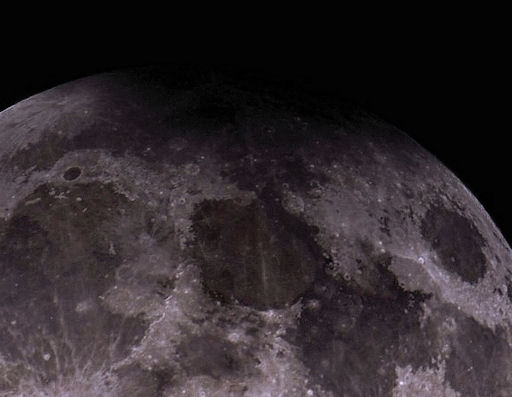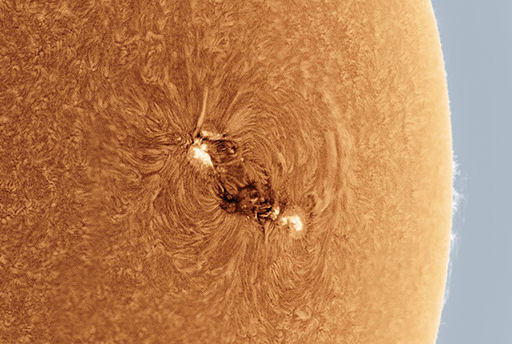Listen to radar echoes from satellites and meteors, live on listener-supported Space Weather Radio. | | |
GEOMAGNETIC UNREST: Today, a fast but thin solar wind stream is buffeting Earth's magnetic field. This is causing some geomagnetic unrest, including a G1-class storm during the early hours of April 26th. High-latitude sky watchers should be alert for auroras shining through the full moonlight. Solar flare alerts: text, voice.
SLIGHT LUNAR ECLIPSE: Last night, the full Moon over Africa, Europe, Asia and Australia passed through the outer edge of Earth's shadow. It was the slightest of eclipses, with less than 2% of the lunar disk falling into darkness. Nevertheless, many sky watchers noticed, such as amateur astronomer Walter Borghini. He sends this picture of the shadow-zone from Casasco (AL), Italy:

As for lunar eclipses, this is as good as it gets until April 15, 2014. On that date, the the Moon will be fully engulfed by Earth's shadow and the lunar disk will turn a dark shade of sunset red. The total eclipse will be visible from the Americas and Australia: map. Until then, browse the gallery for images of last night's partial shadowfall:
Realtime Lunar Eclipse Photo Gallery
BIG SUNSPOT, CHANCE OF FLARES: Sunspot AR1726 is turning away from Earth, but the threat of flares is not subsiding. The sunspot has a delta-class magnetic field that harbors energy for powerful eruptions. NOAA forecasters estimate a 40% chance of M-class flares and a 15% chance of X-flares on April 25th. Solar flare alerts: text, voice.
Amateur astronomer Alan Friedman photographed the sunspot on April 23rd. His H-alpha telescope, tuned to the red glow of solar hydrogen, revealed a seething active region spanning more than 125,000 km (10 Earth diameters) wide:

"The full-sized image reminds me of a Clementine orange," notes Friedman. "I captured the fruity shot through a turbulent jet stream on a beautiful spring day in Buffalo, NY."
The sheer size of the sunspot makes it an easy target for backyard solar telescopes. Browse the gallery for views from around the world.
Realtime Space Weather Photo Gallery
Realtime Aurora Photo Gallery
Realtime Comet Photo Gallery
Realtime Noctilucent Cloud Photo Gallery
[previous years: 2003, 2004, 2005, 2006, 2007, 2008, 2009, 2011]

